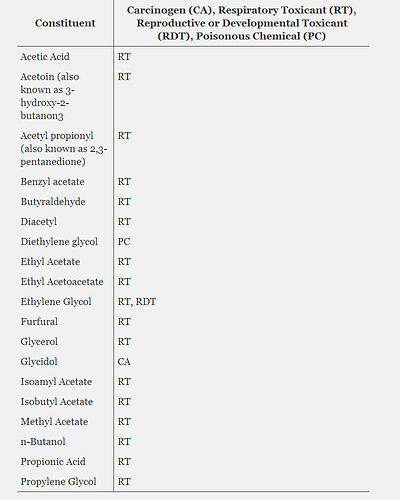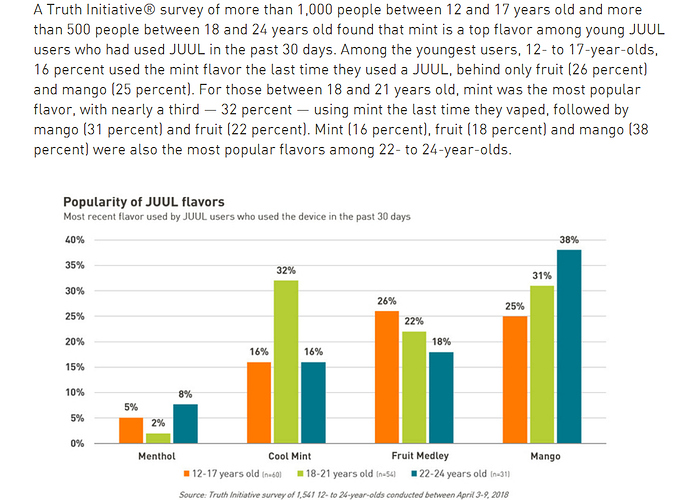Their cannon fodder may be accumulating. Amazingly (to me), “Unicorn Puke” is really and truly “a thing”:
(May, 2018): “Analytical and toxicological evaluation of flavor chemicals in electronic cigarette refill fluids”
(Feb 21, 2019): “High concentrations of flavor chemicals are present in electronic cigarette refill fluids”
(Feb 26, 2019): “Berries/Fruits/Citrus” favored refill fluids were the most popular in three independent methods of analysis. The 20 popular refill fluids contained 22 to 47 different favor chemicals with their total concentrations ranging from 0.63 to 7.9mg/ml. Eighteen flavor chemicals were present in at least one refill fluid at a concentration ≥1mg/ml. 80% of the 20 popular products were cytotoxic in the MTT assay. The four most cytotoxic refill fluids contained various combinations of the six chemicals (ethyl maltol, furaneol, maltol, ethyl vanillin, benzyl alcohol, and vanillin) that were cytotoxic as authentic standards. Most of these chemicals were present in the cytotoxic refill fluids at concentrations >1mg/ml. Maltol and ethyl maltol, which were highly toxic, were present in 19 and 13 of the 20 refill fluids, respectively. The cytotoxicity of refill fluids was directly correlated with ethyl maltol concentrations in the fluids. These data raise concerns about the safety of popular EC refill fluids as those tested all contained concentrations of flavor chemicals that would be cytotoxic at the concentration in the undiluted fluids.
“Identification of Cytotoxic Flavor Chemicals in Top-Selling Electronic Cigarette Refill Fluids”
(Apr 17, 2019): “High-Nicotine Electronic Cigarette Products: Toxicity of JUUL Fluids and Aerosols Correlates Strongly with Nicotine and Some Flavor Chemical Concentrations”
(Having become something of a NET devotee), I have “no dog” in these synthetic flavor fights. These are long and complicated reports. While it may (possibly) be that these studies are in some (or many) respects flawed in terms of methods and conclusions that are clearly descriptive of, and thus relevant to, real world conditions, the fact that few persons in the populace will likely actually read these reports, and even fewer persons are in positions to (technically) question and challenge the nature and veracity of their publicized “findings” and “conclusions”, means that this situation represents distinct, imminent socio-political dangers.
The extraordinary ease with which the CDC (and now the FDA) have managed to quite falsely - and with what is in multiple respects pathetically flawed and unreliable so-called (garbage) data - convince an ever breathless/brainless “press”, politicians, policy makers, and a large majority of the public that (prescription pharmaceutical) Opioid medications were/are highly dangerous and fatal - where by far the vast majority of dangers/fatalities have been and are demonstrably due to the emergence of illicit Fentanyl(s), which is a direct result of the growing throttling and prohibitions of prescription pharmaceuticals. Their alleged “cure” has in fact engendered, exploded, and sustains this “mortality crisis” itself ! Genocidal idiotic lunacy. The “Iron law of prohibition” (predictably) at work, vastly more people have been and are being harmed by the actions of ham-fisted moral zealots. With blood on their hands, they just keep fallaciously “doubling down”.
Never over-estimate the intelligence of pandering politicians, glory seeking bureaucrats and the “press”, and the average consumer of their click-bait moralistic pseudo-scientific pablum and bite-sized rhetorical tripe. The problem with ignorance is that it feels so much like expertise. Welcome to the Age of Dunning-Kruger.



